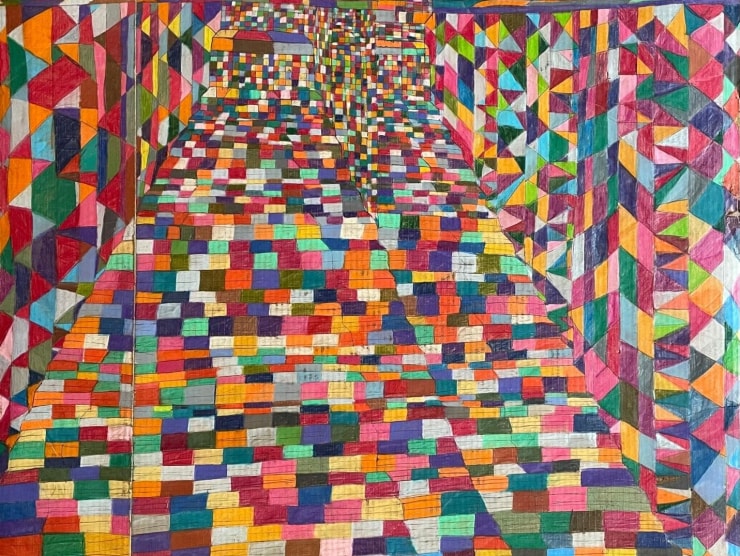
Featuring Myasia Dowdell, James Rosa, Michael Pellew, Carlo Daleo, Robert Latchman
Fetauring Nek Chand, Catherine Garrigue, Norimitsu Kokubo, Jesse James Nagel, Cara Macwilliam, Kenta Ochi, Shinichi Sawada, Yuka Noda
Established early 2017, the Jennifer Lauren Gallery is run solely by Jennifer Lauren Gilbert, an independent gallerist, curator, and producer with over fourteen years’ experience working within this sector. The aim of the Jennifer Lauren Gallery is to champion, advocate for, empower and exhibit disabled, neurodivergent, learning disabled, self-taught, deaf and overlooked artists from across the globe, showcasing undiscovered talents and evolving artists, as well as internationally recognised artists. Jennifer works closely with UK organisations, studios and communities supporting disabled artists and is passionate about being a voice and platform for these under-represented artists, promoting their artworks to wider audiences, allowing their true artistic language to shine. The Gallery organises pop-up exhibitions and events such as artist talks and artist-led workshops, both online and in-person, as well as taking part in art fairs internationally. Alongside this, the Gallery provides consultancy and a solutions-focussed approach to large visual arts galleries, museums and supported studios around the UK, to support working with this group of artists.
Cara Macwilliam (b.1972)
Macwilliam is a self-taught, disabled visual artist. She started being creative in 2018 during a severe relapse, stating that art allows her to travel in ways she no longer can, due to being mainly homebound. There is flow, energy and movement in her art, everything she says her illness has taken away. Macwilliam’s practice involves travelling into surreal landscapes and mythologies using watercolour, dip pens, textiles or clay. Each material adds a different dimension, with a lot of whimsical animism in her work.
Nek Chand (1924-2015)
Chand was one of India’s most celebrated artists, famous for his extraordinary creation in Chandigarh, India, known as the Rock Garden – over 2,000 sculptures of people and animals set in 25 acres of landscaped gardens and great waterfalls. In the early 1960’s Chand, then a transport official, began his creation by clearing a little patch of jungle to form a garden. He began by sculpting figures from recycled materials and gradually his garden grew. He built in secret at night, for fear the local authorities would find out about his illegal garden. When the authorities did find out however, they allowed him to continue his work, paying him a salary and providing him with a workforce. Chand built one of the world’s most astounding creative achievements of modern times.
Shinichi Sawada (b. 1982)
Sawada is a prolific Japanese artist taking around four days to complete each ceramic work. When Sawada works, he demonstrates such confidence and assuredness that it seems he has already envisioned how his final pieces will look. He creates in a hut in the mountains in Japan, with each work being wood-fired following local traditional techniques. His work features in museums and private collections around the world. Sawada is having a touring museum show in America starting at The Mint Museum from April 2014, alongside a new book about his art and practice.
Norimitsu Kokubo (b. 1995)
Kokubo is a Japanese artist who draws freely on several pieces at once, that often contain: cities and buildings, satellites and cars, airplanes and ships... all themes from his childhood or from photos he has taken on trips. His complete disregard for traditional perspectives invites us into an entirely new world and a new sensation.
Catherine Garrigue (b. 1954)
A painful family death and the aftermath of grief led to Garrigue using drawing as a form of release, claiming drawing was an essential act to keep her balanced. It led her to questioning who she really was, to better comprehend her world. Her work is spontaneous and connects with her inner feelings and emotions: “It is the beauty of the mystery of creation”, believing her work to be research into the mystery of the soul.
Interview with Catherine Garrigue from The College of Psychic Studies
Jesse James Nagel (b. 1993)
Nagel was born on a planet that most refer to as Earth and his favourite things are drawing and girls. He finds creating his art exhilarating – “Not like a relaxing chess game, it feels pretty action packed to me. I don't know what is going to happen and there is lots of spontaneity”. His work begins with a few pencil sketches but no real plan, and then he feels his hand just does the work, led by his subconscious and believing it would be ‘boring’ if he knew the final outcome.
Yuka Nohda (b. 1966)
Nohda is known for making ‘Nohdama’, the word deriving from the artists name (Nohda), and the shape of them ‘dama’ meaning round like. ‘Nohdama’ are made by winding raw wool and leftover weaving threads together, inserting cardboard bobbins inside each piece. So far, she has made 30 ‘Nohdama,’ with each piece taking approximately five to six months to complete. These pieces are usually made late at night in the group home, rarely in the actual studio.
Kenta Ohuchi (b. 1984)
With a large sheet of paper flat on the desk in front of him, he paints with bold, sweeping arm movements whilst raising his voice; a sight to behold. He selects his own colours as his work progresses, often enjoying touching how the materials feel on the paper once marks have been made. He has immense energy, moving his whole body as if it were a full-body exercise. The faded parts of his work are the result of the friction between his palm and the crayon, created by repeatedly drawing forcefully in the same spot time and again in large sweeping movements.
Jennifer Lauren Gallery
Manchester, U.K.
+44 07890 075 890
info@jenniferlaurengallery.com
jenniferlaurengallery.com
screen-invert